Persimmons are fascinating fruits (berries technically) that can be grown pretty much anywhere in the world, despite a generally tropical native habitat. Their fleshy fruits are much more varied than you’ll ever find in a supermarket, and well worth growing for yourself.
For a full guide on growing your own persimmons, and a selection of great cultivars to try for yourself, read on.
More...

Family: | Ebenaceae |
|---|---|
Genus: | Diospyros |
Species: | Various |
Common Name: | Persimmon |
Origin: | Wide-spread tropical native trees, some temperate natives |
Location: | Outdoor |
Type: | Fruit tree |
Growth: | Up to 18m tall |
Sun requirements: | Full sun |
Foliage Colour: | Green |
Flower Colour: | White or cream |
Flowering: | Late spring and summer |
Edible Parts: | Edible fruit |
Maintenance level: | Low |
Poisonous for pets: | Non-toxic to cats and dogs |
About Persimmon Trees
Persimmon trees are part of a genus called Diospyros. Not all produce the fruit we know and love, but they do generally share similar growing habits, despite mixed preferences for growing conditions.
Persimmons are winter-fruiting deciduous trees, which might seem unusual when compared to apples and other firm-fleshed fruits, but it connects it to many species of winter fruiting berries, like rowans, Pyracantha or the Australian native holly, Ilex verticillata (‘Winter Berry’).
The majority of fruiting Diospyros, known as persimmon trees, like warm temperature conditions, with mild winters. All grow best on well-drained loam, though cope on most soil types provided there is plenty of organic matter added as a soil improver before planting, and afterwards as a mulch.
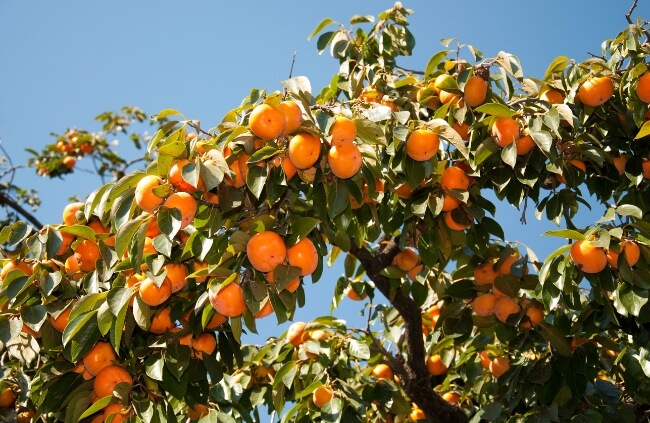
How do Persimmons Grow?
Persimmons are the berries of the persimmon tree. Like most berries, they don’t store well and are best eaten when just ripe, a few days after harvesting.
Unusually for fruit trees, persimmons ripen from early autumn to mid-winter, following late spring and early summer flowers.
Astringent vs Non-Astringent Persimmons
There are two key groups of persimmons to get to know; astringent and non-astringent. Each has different tolerances of cold and heat, and while non-astringent persimmons are generally much sweeter, they don’t store as well.
Astringent persimmons, as the name suggests, are astringent (sour) when initially ripe, and should be left to ripen further off the tree. Non-astringent persimmons can be eaten while still crisp and will store best on the tree, or at room temperature for a couple of weeks.
Diospyros' Natural Habitat
Most fruiting Diospyros (persimmon trees) are native to the southern United States, but the wider genus and a handful of fruiting types are native to the tropics and spread across every landmass that encompasses, including Diospyros australis, a great bush tucker when berries ripen to black, commonly called Black Plum.
(Read our in-depth guide to growing black plum for more details.)
Fruiting persimmons will grow in most warm climates with mild winters, including most of Australia, and even frosty winters can be compensated for by planting in a greenhouse, or with protection from snow.
Persimmon Varieties You Can Grow at Home
Persimmons are incredibly varied fruits, and the bountiful mix of natural species and bred cultivars offer a range of colours, flavours, and fruit sizes. Many are named for their country of origin or connections to the folklore surrounding them, but all (at least those in the list below) can be grown successfully in Australia.
1. American Persimmon
The dusty peach-coloured fruits of the American persimmon are a prized reward for any grower, and the trees themselves offer fabulous structure and stature, often growing to 20 m tall in typical garden conditions.


Get Your Free Guide:
Master Growing Australian Natives eBook
A Must Have Complete Guide for Every Australian Garden
Get Your Free Guide:
Master Growing Australian Natives eBook
A Must Have Complete Guide for Every Australian Garden
Of all the common persimmons in the world, American persimmons are probably the most widely grown, but they are also amongst the most astringent varieties. Once ripe, softened, and ready to eat, there are few sweeter foods, but if eaten when still crisp, the bitterness of American persimmons is almost painful.
2. Eureka Persimmon
Eureka is a self-pollinating astringent persimmon, and fruits can be left on the tree right through winter even in cold weather to ripen. Protect ripening fruit from birds with netting, or by growing under cover, to make the most of your efforts.
These bright orange, near-red persimmons are strikingly beautiful fruits when ripe, and look wonderful in a fruit bowl at the centre of a cosy winter dining table.
3. Fuyu Persimmon
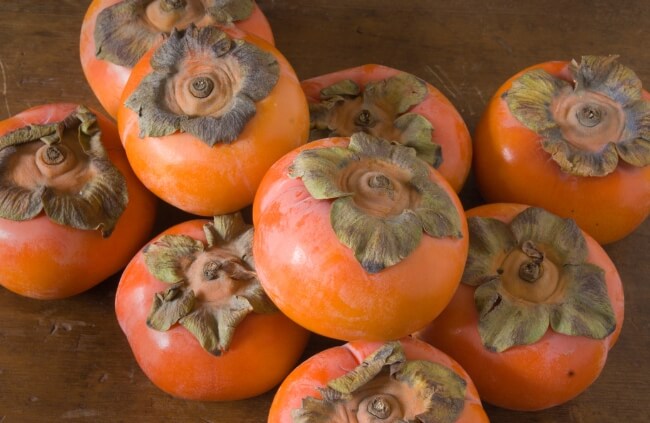
Fuyu persimmons are non-astringent, so can be eaten when still crisp. They are not fertile, so will need to be bought from grafted cuttings, but that generally makes them very manageable plants to keep in the garden.
Avoid leaving them on the plant through winter, as they will generally be eaten by wildlife or drop off prematurely. Instead, ripen in the fruit bowl or store for a few weeks in a fridge.
4. Gailey Persimmon
If you’re growing a few different varieties, but not sure which is self-pollinating, or self-fertile, then Gailey is a useful persimmon to grow alongside them. It is a pollinating persimmon, and self-fertile by itself but will also help others produce fruit.
Its fruit is astringent, but once ripe, retains quite an attractive colour.
5. Giombo Persimmon
With fruits that resemble plum tomatoes when ripe, I can’t help but adore Giombo persimmons. They are incredibly astringent if eaten before they are fully soft and ripe, but they look incredible and the crisp fruit stores for several weeks if not months in a cool fruit bowl before they are ready to eat.
6. Gosho Persimmon
Gosho persimmons are a beautifully sweet non-astringent variety and super easy to grow in Australia. Their skins are a powdery red peppered with orange, and their inner flesh is richly coloured even when still crisp, but exceptionally sweet when left to soften either on the plant or in a fruit bowl.
7. Great Wall Persimmon
The Great Wall persimmon produces a mid-sized fruit that ripens to a dusty, cinnamon-orange colour. They require slightly more chill hours than other persimmons during the growing season to set fruit properly the following year, but if you have the right conditions they are pretty straightforward to grow and produce excellent fruit.
8. Hachiya Persimmon
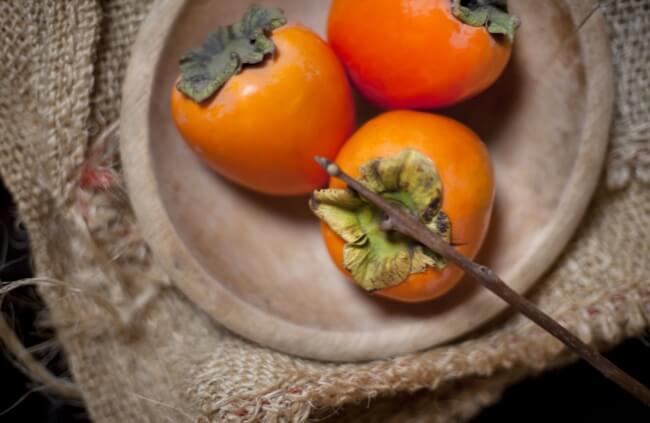
Hachiya persimmons are possibly the bitterest of all but, like all good astringent persimmons, they ripen to an astonishingly sweet fruit. Their fruit is elongated, with small caps, and when they’re ready to ear, the flesh inside is caramel coloured.
9. Hyakume Persimmon
Hyakume, also called the cinnamon persimmon might be astringent, but once ripe it has one of the most deliciously spiced sweet flavours of any variety. They are native to Asia and have thick yellow-orange skins that look beautiful even as they ripen.
10. Izu Persimmon
The firm-fleshed non-astringent persimmon, Izu, is a gardener’s favourite. Ready to eat straight off the tree, and adding a soft peachy-yellow colour to the garden as it ripens. This variety is wonderfully well adapted to Australian gardens and grows well on most soils.
11. Jiro Persimmon

Jiro is a great non-astringent persimmon, with velvety flesh even with still crisp. It’s one of the most commonly grown under commercial cultivation and stores well off the plant, generally ripening during transit.
12. Lotus Persimmon
Lotus persimmon (Diospyros lotus) is a naturally occurring species most commonly called date-plum. It is native to southeast Europe and parts of subtropical Asia, and the elongated waxy leaves are a wonderfully arboreal addition to any garden.
13. Maru Persimmon
Maru persimmons are as close to a typical astringent variety as you can get. Their orange fruits, with a light dusty coating, are incredibly bitter when crisp, but ripen to develop soft brown flesh that is rich in sugars and has a smooth, caramel apple flavour.
14. Saijo Persimmon
The elongated astringent fruit of Saijo persimmons is really quite lovely. It grows best in full sun, with good irrigation through summer. One other big benefit of Saijo persimmons is that they are self-fertile, so don’t require a second plant to pollinate them.
15. Sheng Persimmon
Sheng persimmons are one of the loveliest fruits to harvest. Their waxy fruits are incredibly sweet and can be eaten as soon as they ripen. The ridges across the fruit resemble tiny pumpkins, with distinctly quartered sections.
16. Suruga Persimmon
Suruga persimmons have round, waxy fruit, and are very much non-astringent, offering potentially the sweetest non-astringent persimmon there is. Even once over-ripe, their spiced sweetness just builds and builds.
17. Tamopan Persimmon
For all of us growers who thrive on the unusual, Tampon persimmons are a must. They develop burger-shaped fruits, with an equatorial ridge, which means they look like some sort of underbaked bread. Appropriately, their ripe fruit has a slightly bready sweetness to it too.
18. Tanenashi Persimmon
This seedless astringent persimmon has intriguingly pointed fruit, developing, like all persimmons along the stems of its tree. They are best eaten when fully ripe, and can either be left on the tree to ripen, or stored in a fruit bowl for a couple of weeks.
19. Texas Black Persimmon
The black persimmon, or Texas Black, is an astringent variety that needs to be left for longer than most to ripen fully. Its richly coloured berries are about as close as you can get in nature to true black on any plant, and their tiny leaves make for a really unique garden tree.
20. Velvet Persimmon

Diospyros discolor, the velvet persimmon has, as its common name suggests, a velvety skin, with pale, apple-coloured white flesh inside. It is edible but has a much milder flavour than most other persimmon trees.
How to Grow Persimmon Trees
Persimmons might not seem like it, but they’re pretty simple to grow. Give them the right conditions to begin with, and feed as you would with any other fruiting tree, and you’ll have years of excellent harvests ahead of you.
When to Plant a Persimmon Tree
The best time to plant any deciduous tree is late winter or early spring when they are about to come out of dormancy, but you can, realistically, plant persimmons all year round as long as you give them the right soil conditions.
More important than when you plant persimmons, is how old they are when you plant them. Persimmon trees will only start bearing fruit in their sixth year and usually take a year or two to settle into a new home before fruiting again.
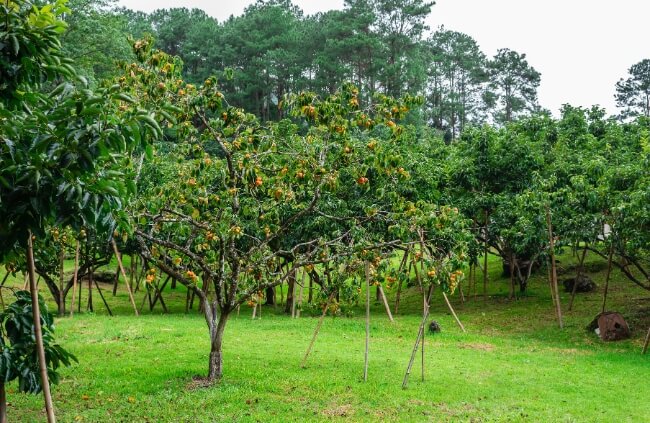
Soil & Drainage
Persimmons will grow on most soil with good drainage. They like moisture, but can’t cope with waterlogging, so avoid damp clay, or very compacted clay loam.
On sandy, granite or chalky soils with fast drainage and little nutrition add loads of organic matter before planting, and dig it right through the planting hole to below the depth of the root ball, and around it. On clay soils, consider growing persimmons in pots.
Light and Temperature
Non-astringent persimmons need warmer growing conditions, so tend to grow best in tropical and subtropical parts of Australia, while astringent varieties can grow in most climates.
Ideally, persimmons should have about 6-8 hours of direct sunlight per day, and autumn temperatures (while the fruit is forming) should be in a range of 16°C to 22°C.
Over winter, temperatures below 7°C for at least a week encourage more productive fruiting of non-astringent persimmons.
Staking Persimmon Trees
Persimmon trees are quite slow to root into new soil, and their tap root can be quite brittle, so it’s important to add a good quality tree stake when planting, and leave that in place for at least the first three years.
When you’ve dug your persimmon planting hole, add a tree stake at a 45-degree angle, facing into the prevailing wind. Plant the tree after inserting the stake so as not to damage the roots, and firm it in with your heel.
Mulch around the base, and use a loose tree tie to secure the tree to the stake, allowing for some movement. Read our in-depth guide on how to stake a tree or plant for more details.
Planting Persimmon Trees in Pots
Persimmons can be grown in pots but need regular root care, and fresh compost added around the root ball every three or four years to support healthy young feeder roots.
Using a water-retentive compost mix, and plenty of drainage added to the base of a large plant pot (50 cm across as a minimum), plant your persimmon tree about 2 inches shy of the pot rim.
Add a vertical tree stake to offer some wind support, and water regularly through summer and autumn, with a monthly liquid fertiliser from September through to harvest.
How to Propagate Persimmon Trees
Persimmons do grow from seed, but as with any cultivated and hybridised fruit, the resulting plant is rarely true to its parent. This is due to a mix of cross-pollination, plants grown on grafted rootstocks to produce dwarf trees, or unreliable genes in select hybrids.
The most reliable way to reproduce persimmons is through semi-hardwood or hardwood cuttings in late spring. Check if your persimmon tree has signs of grating at the base before taking cuttings as the resulting cutting will be true to the fruit and leaf of your existing tree, but may grow more or less vigorously due to different roots.

Propagating Persimmon Trees from Cuttings
To propagate your own persimmon trees, it’s best to wait until late spring, taking cuttings from last year’s growth. Any one-year-old shoots that have hardened off through their first winter, and have already borne fruit, can be used.
Taking semi-hardwood or hardwood cuttings from persimmons in spring means the stems won’t quite have started budding or producing this year’s growth yet and allows a good warm summer to support the development of your cuttings.
Method:
- Start with a 15 cm semi-hardwood shoot, removed from the plant just above a node (this encourages the plant to reshoot to the cut point).
- Pop your cutting into a sealed bag, or glass of water while preparing the rest so it doesn’t start to callous.
- Fill a small plastic pot with free-draining compost or a sandy soil mixture.
- Trim the cutting with an angled cut just below a node, as this is where roots will form. Discard the end.
- Dip the cut end into rooting hormone (gel and powder are equally effective) and plant it straight to the compost.
- Water it thoroughly and then place it in a cold frame, or cover it with a clear plastic bag to retain humidity. Avoid direct sunlight for the first month or two while it focuses on rooting.
- Once new growth starts, remove any coverings and care for your young persimmon tree as you would with any potted tree: Moist but not wet soil and reasonable sunlight.
- Next winter or spring, your persimmon should be ready to plant in the garden, or into a larger container.
Note: Persimmons occasionally produce root suckers (young plants growing nearby the parent from original roots. These young plants can be left to develop until they are about 2 ft tall, then gently dug out with some roots intact and grown on in free-draining, loose compost for a few months before planting.
How to Care for Persimmon Trees
Mature persimmon trees tend to look after themselves but for a gentle touch of compost every couple of years. However, as young trees are establishing, there are some things you can do to boost productivity, support faster rooting, and a speedier onset of fruit.
Mulching Persimmon Trees
Any organic compost, whether it’s garden compost or a manure-based mulch, will boost nutrients and retain soil quality. Keep any mulches 10 cm away from the trunk to avoid causing damp rot at the base of the trunk.
Apply mulch to persimmon trees in late winter or just after harvest so nutrients can work naturally into the soil and support bud and fruit development the following summer.
Watering Schedule
Watering is most important when fruit is forming in autumn, but I would also suggest watering persimmon trees throughout any summer droughts to support flower retention and the resulting pollination process.
Persimmons are drought tolerant, but fruit much better with even weekly watering to maintain good soil structure and support nutrient availability.
Fertilising Persimmon
Persimmons, like any deciduous fruit tree, will largely fend for itself once fully established, particularly with a biennial mulch to add balanced nutrients back into the soil.
However, for young persimmon trees, or newly planted trees, a monthly balanced liquid fertiliser, or soil activator (tomato feed, liquid seaweed, nettle tea, etc.) will support new roots as they establish.
For commercial propagation, or to encourage cropping, apply nitrogen and potassium in summer as buds develop, and again when fruits set, and as they develop. Add phosphorus separately after fruiting (this can generally be done with late winter mulch of compost or rotted manure).
Pruning Persimmon Trees
Persimmons can be trained and pruned in a variety of ways. Like any deciduous fruit tree, they lend themselves very well to wall training and tightly controlled espaliers. However, this pruning should begin early in its life, and be continuously up kept on an annual basis each year after fruiting.
Persimmon fruits develop on new growth, so winter pruning will encourage next year’s growth. For a more natural tree, simply leave it to develop, only pruning weak or damaged growth, and removing branches that have stopped producing fruit.
Harvesting Persimmon Fruits
Persimmons are spectacularly lovely-looking trees, but let’s face it, the only reason most of us grow them is to harvest their luxuriously juicy, thick-fleshed, sweet fruits. This step, the harvest, is unlike most other fruit trees you’ll ever grow, as they ripen in late autumn and winter.
On most varieties of persimmon, fruit can actually be left on the tree right through winter before harvesting, and if the birds don’t get to the fruits before you do, it’s the easiest way to store them.
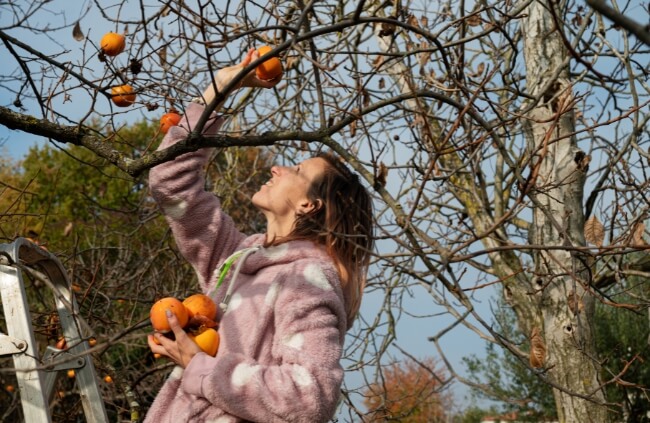
When to Harvest Persimmons, and How to Store Them
Persimmons are ready to harvest when their skins have darkened and they are just soft enough to slightly squeeze. Fruits should pull away from the tree easily without twisting or tugging, and the fresher they are when you eat them, the better they taste.
Non-astringent persimmons are at their best when still slightly crisp but soften nicely if left to ripen indoors in a fruit bowl.
Astringent persimmons will ripen off the tree and can be stored frozen or fresh in fridge freezers for around a month. It is at its best when the fruit has softened, and sugars have been released.
Common Problems When Growing Persimmon Trees
In their leaves, buds, fruits, and running up their trunks, branches and shoots, persimmons have such an abundant supply of nutrients and sugars that there aren’t many pests that can resist it.
Thankfully, these deciduous trees are fairly resistant to pests, and any damage caused in one season is usually dropped when leaves fall, and fresh growth replaces it the following year.
However, in some poor soil conditions, persimmons may suffer root rots and crown rots that require more urgent treatment.
Persimmon Pests
The list of persimmon pests is long, so I won’t go into detail about how to treat each individual pest, but as a general rule, aphids, and small invertebrates can be removed with neem oil, discouraged with organic foliar sprays, and controlled with water management.
Caterpillars, moths, weevils and beetles are best dealt with by hand, removing and disposing of them however you see fit. And fruit-focussed pests that eat or bore into persimmon berries will need disposing of along with any berries they are inside.
The most common persimmon tree pests in Australia are listed below:
- Fruit flies
- Scale (various)
- Caterpillars (various – particularly leaf borers)
- Leaf Beetles (various)
- Apple Moths and Peach Moths
- Mites (all spider mites, but particularly two-spotted mites)
- Thrips
- Weevils
- Aphids
- Earwigs
- Mealybugs
- Citrus Nematodes
Persimmon Tree Diseases
As a result of pest infestation, or damp growing conditions, some disease – usually fungal – can develop on persimmon trees, usually showing initial symptoms through weak or sluggish new growth in spring.
Leaf Spot
Angular leaf spot, Pestalotiopsis leaf spot and circular leaf spot are the three most common leaf diseases for persimmon trees. Generally speaking, they can be dealt with by removing affected leaves and burning them, and recurrence can be prevented by removing any dropped leaves in winter.
Crown Gall
Galls are swollen growths along the stem of any plant. Crown gall in persimmons usually occurs underground but can develop high up the trunk, especially on younger plants.
It is caused by a soil-borne bacteria (Agrobacterium tumefaciens) that attach to the roots of plants growing in moist, warm, conditions. Once it takes hold, crown gall is not treatable, but will not kill mature trees.
If it develops on new trees, remove the tree and plant grasses for three or four years on the affected soil to remove the bacteria, then try again.
Mould
Sooty mould and grey mould, two simple fungal infections spread by wind onto pest-damaged leaves, can affect leaves, shoots, and fruits. Grey mould is caused by the common garden fungal problem – Botrytis, while Sooty Mould is caused by several common moulds, forming black moulds in sheets across leaves and fruits.
Both are promoted by the damage to leaves of various pests, and particularly supported by pests like aphids that leave sticky secretions behind for fungal spores to attach to.
Anthracnose
Anthracnose affects fruit and leaves, but most noticeably shows symptoms with black spots littered over the skins of ripening fruit. The problem with anthracnose for persimmons is that it is caused by damp conditions during fruiting.
On most fruit trees in Australia, that means they’ve long been harvested by the time anthracnose is most prevalent. Unfortunately for persimmons, the anthracnose season is winter… when they are ripening. Remove infected fruit and bin it.
The disease can live on in compost and affect other fruit next year. The only course of action is regular checks until it’s under control.
Collar Rot
The only early symptom of collar rot is a general reduction in productivity and overall vigour of trees. If your persimmon stops producing fruit or produces significantly lower yields than last year, mulch heavily, with nitrogen and potassium-rich feeds, and pinch off at least half of next year’s fruit to reduce strain on the tree.
Persimmon trees can recover from collar rot but will, sadly, usually succumb to its all-encompassing spread through their system.
Persimmon Tree Frequently Asked Questions

Do persimmon trees have invasive roots?
Persimmon trees don’t have invasive roots. Their tap roots are really quite brittle, so they tend to work their way around any hard materials. And with an ultimate height of about 10-18m, they can be grown reasonably close to buildings.
Can you grow a persimmon tree from a persimmon fruit?
While any tree grown from a persimmon fruit might not grow accurately to the fruit itself, it is possible to grow a persimmon tree from a store-bought fruit.
The best method is to ferment the fruit in a covered bucket and then remove the seeds by soaking them before planting – but it’s possible to grow them without fermenting the fruit if you prefer to avoid that process.
What is the lifespan of a persimmon tree?
Persimmon trees have a lifespan of around 60 years in terms of productiveness, but the tree itself can continue fruiting and survive for hundreds of years. In commercial cultivation, persimmons are actively useful for harvesting for around 40-60 years.
How fast does a persimmon tree grow?
Persimmon trees are quite fast growing, at least compared to most other deciduous fruit trees. They put on about 1-2 ft of new growth each year, eventually reaching around 10-18 m tall.
Wrapping Up Our Guide to Growing and Caring for Persimmon Trees
Most of the pests and diseases that affect persimmon trees are rare in gardens. They are more of a problem for commercial growers, or for persimmons grown in mixed orchards, where disease spreads more readily, and pests cross from one plant to the next.
So, don’t let potential problems put you off growing something that can provide flavourful treats in winter, without asking much in return. Persimmons, once established, are incredibly easy-going trees and add seasonal structure and drama to a garden. Growing your own persimmon tree is a must if you have the space.
Published on November 8, 2023 by Maisie Blevins
Last Updated on February 25, 2025




